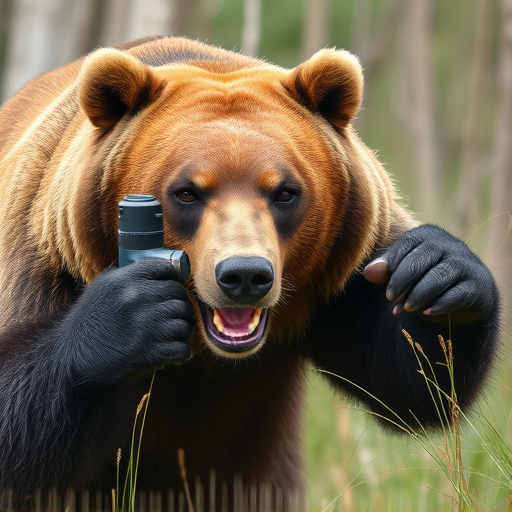Bear spray, a pepper-based aerosol, is an effective deterrent within 30 feet, according to research, aiming at bears' faces and eyes for maximum effectiveness. Its performance is influenced by wind, terrain, and user technique, with proper usage crucial for safety in bear country. While providing valuable retreat time, it's not a replacement for safety practices.
- Understanding Bear Spray: A Closer Look at Its Composition and Mechanism
- The Science Behind Bear Spray Range: Factors Influencing Effectiveness
- Real-World Scenarios: Evaluating Bear Spray Performance in Various Conditions
- Safety and Best Practices: Using Bear Spray Responsibly and Effectively
Understanding Bear Spray: A Closer Look at Its Composition and Mechanism
Bear spray, also known as bear repellent, is a specialized pepper-based aerosol designed to deter aggressive bears when faced with a close encounter in their natural habitat. Understanding its composition and mechanism is key to comprehending its effectiveness. The primary active ingredient in most bear sprays is capsaicin, the same compound that gives chili peppers their heat. This irritates the bear’s eyes, nose, and respiratory system, causing them to back away from the source.
Research on bear spray effectiveness has shown it to be highly reliable within a range of thirty feet. Studies have demonstrated that bears typically retreat quickly when sprayed, reducing the risk of injury to humans. However, factors like wind direction, bearing, and concentration of the spray can influence its success. Proper usage, including aiming for the face and eyes of the bear, is crucial to maximizing its effectiveness during encounters in bear country.
The Science Behind Bear Spray Range: Factors Influencing Effectiveness
Bear spray, also known as bear repellent, has become a popular tool for outdoor enthusiasts and individuals living in areas frequented by bears. When it comes to understanding its effective range, it’s not just about the distance, but rather a complex interplay of various factors. The science behind bear spray range involves intricate chemical reactions and behavioral responses.
Research indicates that bear spray is most effective within a thirty-foot (10 meter) range, which is based on experimental studies simulating encounters with bears. This range offers a balance where the spray can create a barrier without causing permanent harm to the animal. Several variables influence its effectiveness, including air currents, terrain, and the bear’s behavior. For instance, a calm day with minimal wind allows for better dispersion of the spray, ensuring it reaches the bear’s eyes and respiratory system. Conversely, strong winds might carry the spray away from its target. Additionally, the angle and proximity of the user to the bear play a role; spraying directly into the bear’s face has been shown to be more successful than applying it at an angle. Understanding these factors is crucial for users to maximize the effectiveness of bear spray during potential encounters.
Real-World Scenarios: Evaluating Bear Spray Performance in Various Conditions
In real-world scenarios, bear spray has proven its effectiveness in deterring bears and providing vital time for escape or retreat. Studies have shown that when used properly, bear spray can be effective up to a range of thirty feet. This means that individuals in remote outdoor areas, such as hikers, campers, and wildlife managers, can carry this non-lethal deterrent as a last line of defense against aggressive bears.
Various factors influence the performance of bear spray, including weather conditions, terrain, and the specific behavior of the bear. Research indicates that wind direction plays a significant role; spraying into the wind may reduce the effective range, while spraying with the wind can enhance coverage. Additionally, altitude and temperature can also impact the spray’s potency and dispersion, highlighting the importance of understanding local environmental conditions when relying on bear spray for protection.
Safety and Best Practices: Using Bear Spray Responsibly and Effectively
Bear spray, also known as bear repellent, is a popular choice for outdoor enthusiasts navigating bear country. When used responsibly and effectively, it can significantly reduce the risk of bear attacks. However, understanding best practices is crucial to ensuring its efficacy within its stated range of thirty feet (or 10 meters).
Research indicates that bear spray creates a barrier of capsaicin-based chemicals, temporarily blinding and disorienting bears. To maximize its effectiveness, users should aim for the face and eyes of the bear, as these are sensitive areas. It’s important to remember that bear spray is not a substitute for awareness and distance. Always maintain a safe distance from bears, follow local guidelines, and only use spray as a last resort. Proper usage within the stated range can provide valuable time for retreat or de-escalation of a potentially dangerous encounter.
Bear spray has proven to be a valuable tool for personal safety in bear country, with an effective range of up to thirty feet. Through understanding its composition, the science behind its range, and real-world performance, we can confidently employ bear spray responsibly. Ongoing research ensures optimal effectiveness, making it a game-changer in navigating and appreciating the wilderness while minimizing risks from these majestic yet potentially dangerous animals.
